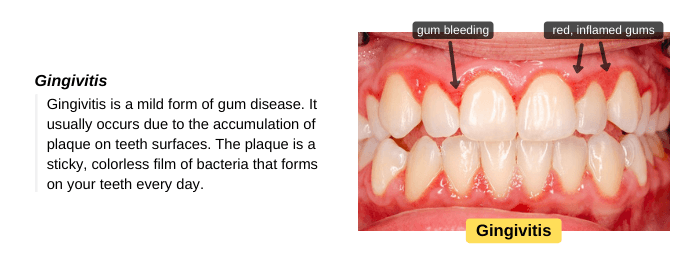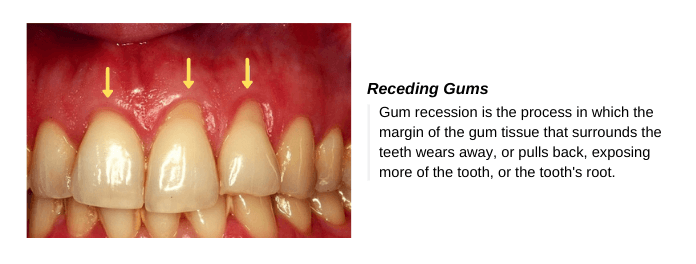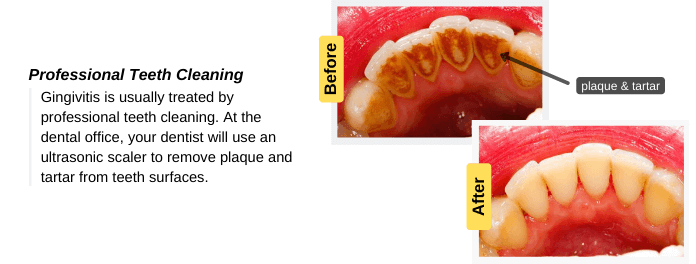Gingivitis is the early stage of gum disease. It usually occurs due to the accumulation of plaque on teeth surfaces. If gingivitis is left untreated, the infection may spread to the tooth-supporting tissues, causing complications such as gum abscess and tooth loss. Recognizing the signs and symptoms of gingivitis will help you treat the problem early and prevent complications.
What is Gingivitis & its Causes?
Gingivitis is a mild form of gum disease. It usually occurs as a result of the accumulation of dental plaque on teeth surfaces. Dental plaque is a sticky, colorless film of bacteria that form on your teeth every day. Plaque bacteria decompose carbohydrates and produce toxins that irritate gums, causing gingivitis. Plaque can easily be removed by tooth brushing and flossing. If plaque is left on tooth surfaces, it will harden into tartar, which can’t be removed by brushing or flossing. So, you have to visit your dentist for professional teeth cleaning. Both plaque and tartar irritate gums, causing the signs and symptoms of gingivitis.
Other Causes & Risk Factors
Anyone can develop gingivitis. Risk factors and causes of gum infection and gingivitis include:
- Not brushing or flossing your teeth regularly.
- Broken tooth restorations or badly fitted prostheses.
- Smoking or chewing tobacco.
- Dry mouth condition.
- Vitamin C deficiency.
- Hormonal changes during pregnancy or menstrual cycle or due to the use of birth control pills.
- Some medications such as drugs used for angina or high blood pressure.
- Some medical conditions such as certain viral and fungal infections.

Signs & Symptoms of Gingivitis You Should Never Ignore
Healthy gums are pink, firm, & fit tightly around teeth. Note: the color of healthy gums ranges from light pink to brown or even black, depending on your ethnicity. The signs and symptoms of gingivitis include:
Red, Swollen Gums
You will notice inflammation and redness along the gumline. This inflammation usually occurs due to the accumulation of plaque on teeth surfaces. Your gum should be pink and firm. Read more about “gingivitis vs healthy gums“. So, you should make an appointment with your dentist, especially if the swelling and gum infection last for several days.
Bleeding Gums – One of The Common Signs & Symptoms of Gingivitis
Gums shouldn’t bleed when you brush your teeth. Gum bleeding is one of the warning signs of gingivitis. Gum bleeding occurs due to the build-up of plaque below the gumline. Sometimes, it may occur without any stimulation. Many people stop brushing their teeth when they notice gums bleeding, which allows plaque build-up and increases the problem. So, if you noticed gum bleeding, continue brushing your teeth with fluoride toothpaste and schedule an appointment with your dentist.
Gums Tender to Touch
Healthy gums don’t cause discomfort or pain. When your gums hurt when you eat or are tender to touch, This may indicate that you have gingivitis. So, you need to schedule an appointment with your dentist.
Receding Gums
Healthy gums fit tightly around your teeth. When the inflammation continues, the gums begin to pull back, exposing the tooth’s root. This condition is known as gum recession. The teeth may appear longer than usual, especially the anterior teeth. Receding gums is one of the advanced signs and symptoms of gingivitis, which can cause an aesthetic problem. If you didn’t treat it early, it may progress and cause permanent damage. Sometimes, receding gums may occur as a result of a wrong tooth-brushing technique. So, follow the right tooth-brushing technique and use a soft-bristled toothbrush.

Bad Breath
Bad breath usually occurs due to the smelly gases produced by bacteria. Don’t cover it up with gums, mints, or mouthwash because they won’t treat the underlying cause. Untreated gingivitis can cause complications such as gum abscesses and tooth loss.
Sensitive Teeth
Tooth sensitivity can occur due to gum recession and the exposure of the tooth’s root. Exposed root surfaces are more susceptible to cavities and tooth sensitivity. Visit your dentist to treat the underlying cause and treat the signs and symptoms of gingivitis.
Complications
If gingivitis is left untreated, the severity of the signs and symptoms may increase, and complications may occur. Also, it can affect your overall health. Complications include:
- Pain and discomfort.
- Severe gum recession.
- Persistent bad breath.
- Severe tooth sensitivity.
- Gum abscess, which may progress to a periapical abscess.
- Tooth mobility and tooth loss.
How to Reduce the Signs & Symptoms of Gingivitis at Home? (Home Remedies)
Here are a few instructions to help you reduce the signs and symptoms of gingivitis at home:
- Brush your teeth with a soft-bristled toothbrush and fluoride toothpaste.
- Rinse your mouth with antimicrobial mouthwash or warm salt water to help fight the infection.
- Take over-the-counter (OTC) pain medication to help reduce swelling and pain.
- Avoid eating hard-to-chew foods.
- Use dental floss to remove plaque and food debris from between teeth.
These instructions will help you reduce the signs and symptoms but won’t eliminate the need for a visit to the dentist to treat the underlying cause.
How Is Gingivitis Treated?
Gingivitis is usually treated by professional teeth cleaning and eliminating the underlying cause, for example, replacing the broken tooth filling or the poorly fitted bridge. If you noticed the signs and symptoms of gingivitis, you have to visit your dentist as soon as possible for treatment and to prevent the spread of the infection in the gums. Your dentist will use an ultrasonic scaler to remove plaque and tartar from teeth surfaces. Then, they will polish your teeth to make them smoother. In some cases, your dentist may prescribe antibiotics to help control the infection.

How to Prevent Gingivitis and its Signs & Symptoms?
Maintaining good oral hygiene can help reduce your chances of getting gingivitis. Also, recognizing the signs and symptoms can help you treat gingivitis early. Things to do to prevent gingivitis include:
- Brush your teeth at least twice daily with a soft-bristled toothbrush and fluoride toothpaste.
- Use dental floss to remove dental plaque from between teeth.
- Follow the proper brushing and flossing technique.
- Use an antimicrobial mouthwash.
- Avoid foods high in sugar such as cookies, cakes, and sweets.
- Eat foods rich in nutrient-rich foods.
- Schedule an appointment with your dentist every 6 months for professional teeth cleaning.